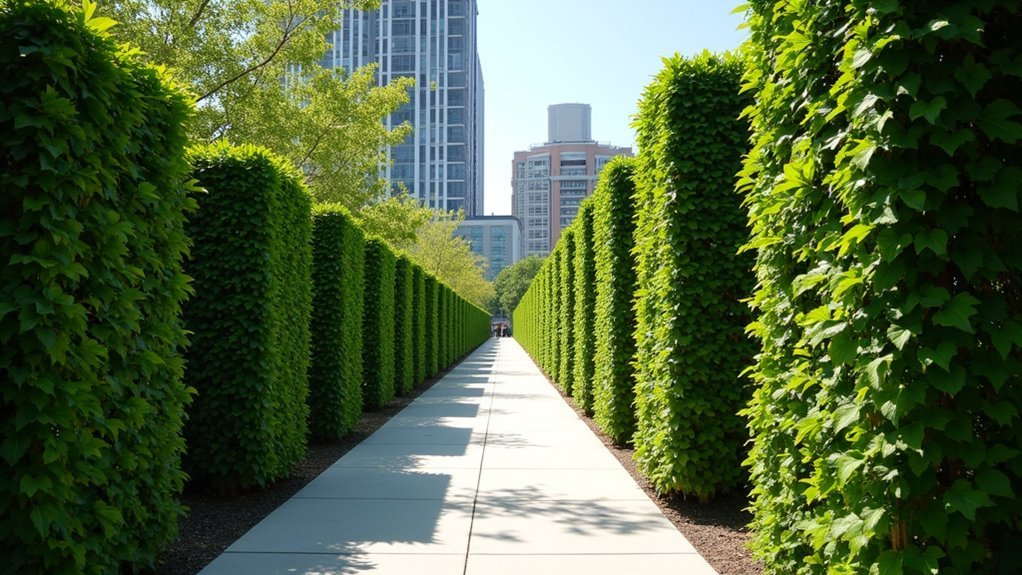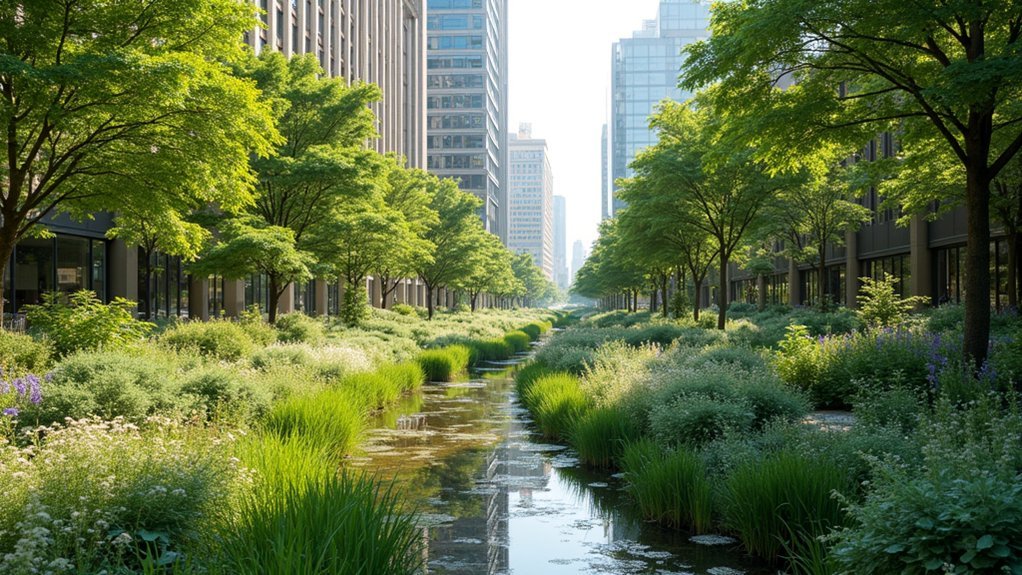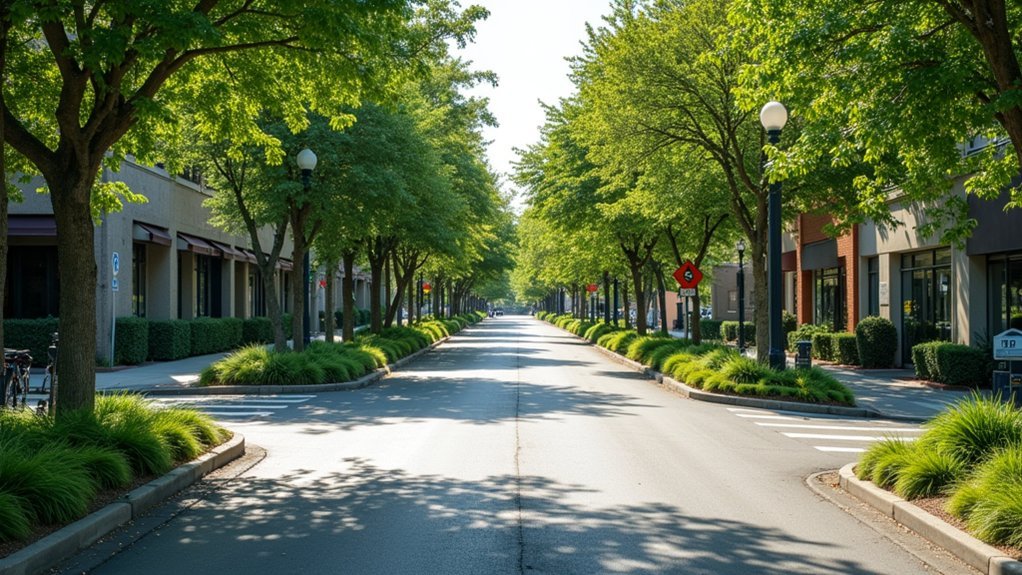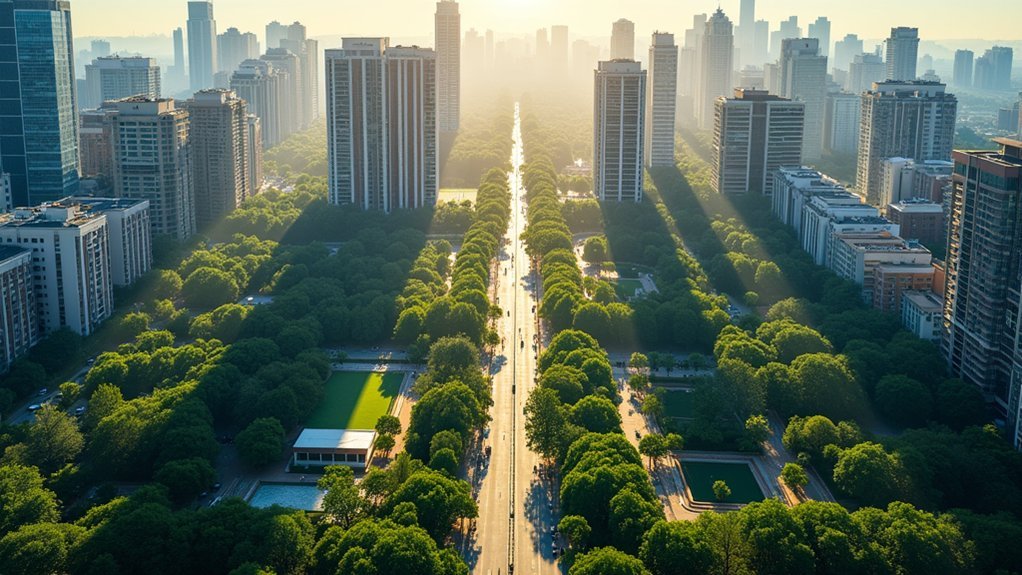Urban barrier setback laws vary by location, but you’ll typically need to maintain 10-25 feet from front property lines and 5-15 feet from side/rear lines. Front yard hedges can’t exceed 3-6 feet, while rear barriers may reach 8 feet. Keep intersection visibility triangles clear (15×15 feet), guarantee proper water drainage, and use native plants when possible. Permit applications require property measurements and planting plans. These regulations protect both your property rights and neighborhood safety.
10 Best Urban Barrier Setback Laws To Know

While maneuvering through property development in urban areas, you’ll need to understand setback laws that govern the minimum distance between structures and property lines.
These regulations vary greatly between municipalities, with residential zones typically facing stricter requirements than commercial or industrial areas.
Front yard setbacks commonly range from 10 to 25 feet, while side and rear setbacks usually require 5 to 15 feet of clearance. Understanding these parameters is essential before finalizing any construction plans.
If your property has unique conditions, you might qualify for a variance, but you’ll need to demonstrate that standard compliance would create a genuine hardship.
Don’t overlook these requirements – non-compliance can lead to expensive alterations, mandatory structure removal, and potential legal battles with local authorities.
Residential vs. Commercial Natural Barrier Requirements
Natural barriers function differently based on property type, with distinct rules governing residential and commercial installations.
Landscape regulations vary by zoning type, creating separate standards for homeowners and businesses.
For your home, setbacks typically require 10-20 feet from property lines, with allowances for hedges and shrubs to extend into these areas if kept below 3-4 feet in height. This flexibility often doesn’t apply to a residential fence, which must strictly adhere to setback requirements.
Commercial properties face more stringent regulations, with wider buffer zones ranging from 15-30 feet to minimize impacts on neighboring areas. These larger setbacks help mitigate noise and visual disruptions.
Both property types must maintain clear sightlines at intersections, with height restrictions within visibility triangles. Many municipalities also specify acceptable vegetation types, often favoring native species that require less maintenance and provide environmental benefits.
Height Restrictions for Living Fences and Hedges

Living fences and hedges must comply with specific height regulations that vary depending on their location on your property.
Most municipalities limit front yard hedges to 3-6 feet to maintain visibility and neighborhood aesthetics, while side and rear yard barriers may extend up to 8 feet if they don’t obstruct sightlines.
- You’ll need to regularly trim your living fence to stay within legal height restrictions and prevent encroachment onto neighboring properties.
- Your hedge shouldn’t exceed the height of adjacent structures or fences in certain jurisdictions.
- Height restrictions for living fences and hedges are stricter in front yards than in side or rear areas.
- Exceeding allowable heights may require permits, and non-compliance can result in fines or mandatory removal.
Property Line Setbacks for Green Barriers
You’ll need to position your green barriers 2-5 feet from your property line to comply with most urban vegetation buffer requirements.
Your local zoning codes may permit taller trees within the setback area if they don’t exceed 6-8 feet in height, though this varies by residential zone.
When planning your eco-fence installation, remember that you’re responsible for preventing encroachment onto neighboring properties or public rights-of-way to avoid potential disputes.
Vegetation Buffer Requirements
While concrete walls and fences serve practical purposes, vegetation buffers represent a more sustainable approach to property line demarcation.
You’ll need to adhere to vegetation buffer requirements that typically mandate 10-50 feet of space between property lines. These natural barriers must often achieve 50% opacity at maturity to effectively screen neighboring properties.
- Native plant species are frequently required within buffer zones to promote local biodiversity
- Environmental considerations may impose additional setbacks near sensitive areas to prevent runoff
- Limited decorative elements like pathways or low fences may be permitted within buffer zones
- Buffer maintenance must follow local codes regarding height, width, and plant density
Your vegetative buffer not only satisfies legal requirements but also enhances aesthetics while supporting local ecosystems with minimal long-term maintenance costs.
Eco-Fence Legal Guidelines
As sustainability becomes a priority in urban planning, eco-fence regulations have evolved to balance environmental benefits with property boundaries.
You’ll need to adhere to setback requirements that typically range from 5 to 15 feet, depending on your local regulations and the type of barrier you’re installing.
Unlike traditional fencing, eco-fences incorporating vegetation may qualify for special exemptions in many jurisdictions.
These green barriers often receive preferential treatment through reduced setbacks or streamlined permitting processes.
Before installation, check your municipality’s height restrictions—most limit fences to 6-8 feet without permits.
Setbacks may vary based on proximity to sidewalks and streets to maintain pedestrian visibility and safety.
Take advantage of available incentives for environmentally friendly barriers that meet green infrastructure standards, as these could ease regulatory requirements for your property.
Wildlife-Friendly Buffer Zone Regulations

Wildlife-friendly buffer zones of 100-300 feet establish essential separation between human development and sensitive ecological areas, preserving natural migration routes for urban wildlife.
You’ll need to incorporate native vegetation within these protective boundaries, which helps maintain habitat connectivity and supports local biodiversity.
These buffer regulations also restrict harmful activities like clear-cutting and pesticide use, with many jurisdictions offering tax incentives for property owners who participate in these conservation efforts.
Wildlife Migration Corridors
Because urban expansion continues to fragment natural landscapes, wildlife-friendly buffer zone regulations have become indispensable tools for protecting animal movement patterns.
These zoning laws establish setbacks ranging from 100-300 feet where development must maintain distance from identified migration routes.
When developing property near wildlife corridors, you’ll need to:
- Complete wildlife impact assessments before receiving permits
- Maintain required setbacks (typically 100-300 feet depending on local species)
- Incorporate native vegetation to provide food and shelter
- Consult with wildlife agencies to guarantee compliance with conservation goals
These regulations don’t just protect animals—they maintain ecological connectivity that’s essential for biodiversity.
Native Habitat Protection
Beyond protecting migration corridors, effective urban planning must address the preservation of entire native habitats.
Wildlife-friendly buffer zone regulations typically mandate setbacks of 50-100 feet from wetlands and forests to safeguard native species and their ecosystems. These laws regulate the shift between developed areas and natural environments, reducing human-wildlife conflicts while maintaining ecological integrity.
You’ll need to incorporate native vegetation within these buffer zones, as many municipalities require these plantings to enhance biodiversity and support local wildlife.
These strategic setbacks also improve water quality by filtering pollutants and reducing urban runoff.
To guarantee long-term effectiveness, you must participate in periodic assessments and monitoring programs that evaluate how well your property’s buffer zones support surrounding habitats.
Maintenance Standards for Natural Urban Boundaries
Although natural boundaries provide ecological benefits and aesthetic value to urban environments, they require consistent maintenance to function properly as effective barriers.
Local laws typically mandate regular assessments to prevent vegetation from encroaching on public rights-of-way or blocking visibility at intersections.
You’ll need to comply with these essential maintenance requirements:
- Remove invasive species to promote biodiversity and maintain ecological balance
- Follow regular trimming schedules to prevent hazards and preserve aesthetic value
- Maintain proper stormwater management by keeping natural barriers clear for drainage
- Adhere to vegetation height and density regulations to avoid fines
Failure to meet these standards may result in penalties from your municipality, as these requirements guarantee both safety and functionality of natural urban boundaries while contributing to community well-being.
Permitting Process for Natural Fence Installation

To begin your permit application for a natural fence, you’ll need to gather detailed property measurements, vegetation specifications, and homeowners’ association approval documents before submitting them to your local zoning department.
If your planned hedge or living barrier doesn’t comply with standard setback requirements, you can file a variance request that explains the special circumstances warranting an exception to existing regulations.
Your variance application should include compelling reasons such as terrain challenges, wildlife considerations, or aesthetic improvements that benefit the broader community rather than just personal preferences.
Permit Application Guidelines
When planning to install a natural fence on your property, you’ll need to navigate the permitting process before breaking ground. Your local planning department requires permits to guarantee your fence complies with zoning laws and setback requirements, especially for fences exceeding 6 feet in height.
Your application should include detailed site plans showing:
- Proposed fence location relative to property lines
- Placement in relation to existing structures
- Height and materials of the planned natural barrier
- Safety considerations for visibility at intersections
You’ll need to demonstrate that your fence won’t create hazards for pedestrians or drivers.
Before submitting your permit application, consult with zoning officials to understand specific requirements for your area, including any restrictions on plant species or maintenance expectations.
Variance Request Procedures
If your natural fence plans don’t align with standard setback requirements, you’ll need to pursue a variance request through your local zoning board. This formal application requires detailed documentation that demonstrates why your property’s unique conditions justify deviation from standard regulations.
Before submitting your variance request, thoroughly research your municipality’s specific criteria for approval. Many jurisdictions require evidence of hardship or special circumstances that make compliance difficult.
Be prepared for public hearings where neighbors can voice opinions about your proposed installation.
Your application should include property surveys, detailed installation plans, and written justification for the variance. Don’t skip this critical step—proceeding without proper approval could result in hefty fines or forced removal of your fence.
Contact your local zoning office early in your planning process to understand all requirements.
Water Runoff Considerations for Barrier Plantings
Managing water runoff effectively stands as a critical yet often overlooked aspect of urban barrier plantings.
When planning your barrier installation, you’ll need to comply with laws and regulations that mandate specific setback distances to preserve natural drainage patterns. Properly designed barriers can reduce surface runoff by up to 30% compared to traditional landscaping.
- Select vegetation that matches your local rainfall patterns and soil conditions
- Incorporate permeable materials to allow water infiltration rather than surface flow
- Position plantings strategically to minimize erosion risk in high-flow areas
- Consider how your barrier might affect neighboring properties’ drainage
Remember that local ordinances often require professional assessment of potential runoff impacts before approval, ensuring your barrier enhances rather than disrupts the urban water management system.
Visibility Triangle Rules at Street Intersections

Safety at street intersections depends heavily on proper visibility for all road users. Visibility triangle rules typically require maintaining a clear 15×15 feet triangular area from intersection corners, free from structures or vegetation that exceed specified heights.
These regulations guarantee drivers and pedestrians have unobstructed sightlines when approaching intersections.
Before planning any barrier plantings or structures near street corners, you’ll need to consult your local zoning laws, as municipalities may have varying requirements for visibility triangles.
Failing to comply can result in penalties or mandatory modifications to your property.
When designing landscapes or constructing fences near intersections, always prioritize these visibility requirements.
Proactive assessment of these regulations will help you avoid creating hazardous conditions while keeping your property in compliance with local ordinances.
Historic District Special Provisions for Living Boundaries
Historic districts maintain specialized setback regulations for living boundaries that differ substantially from standard residential zones.
When you’re planning landscaping or fencing in these areas, you’ll need to understand the unique requirements designed to preserve the area’s character.
Many historic districts enforce stricter property line distances for accessory structures while some offer reduced setbacks for primary buildings to maintain traditional streetscapes.
- You’ll need preservation board approval before altering any boundary elements, even living ones like hedges.
- Height restrictions often correlate with setback measurements to maintain the district’s visual cohesion.
- Different rules typically apply to fences, walls, and vegetation barriers than in regular neighborhoods.
- Traditional planting patterns may be required to comply with district-specific landscaping guidelines.
Frequently Asked Questions
What Are the Minimum Setback Distances?
Minimum setback distances vary widely by municipality. You’ll typically find front yard setbacks of 15-25 feet, side yard setbacks of 5-10 feet, and rear yard setbacks of 10-30 feet. Commercial properties often require 10-50 feet.
What Is a Setback in Urban Planning?
A setback in urban planning is your property’s required minimum distance from a structure to the property line. It guarantees proper spacing, utility access, and maintains neighborhood aesthetics while protecting privacy and natural light access.
What Is the Minimum Distance to Build From the Property Line?
You’ll find property line setbacks vary widely from 5-50 feet depending on your local zoning laws. Front yard setbacks typically require 10-30 feet, while side and rear setbacks usually range from 5-15 feet.
How Close Can You Build to Property Line Houston?
In Houston, you’ll need to maintain a 25-foot front yard setback, 5-foot side yard setbacks, and 5-foot rear setbacks for structures. Fences under 8 feet tall don’t require permits but must respect property boundaries.
In Summary
You’ve now mastered the essentials of urban barrier setback laws. Remember, you’ll need different approaches for residential versus commercial properties, and don’t forget those visibility triangles at intersections. Before planting your living fence, check your local permitting requirements and historic district guidelines. With these regulations in mind, you’ll create beautiful, compliant natural boundaries that work for both your property and community.





Leave a Reply